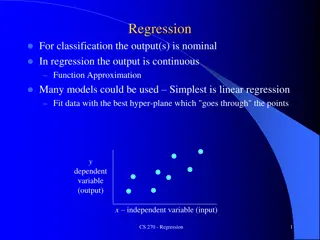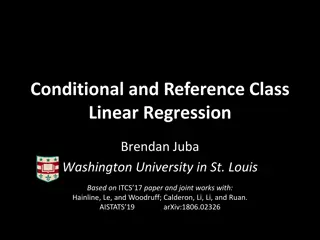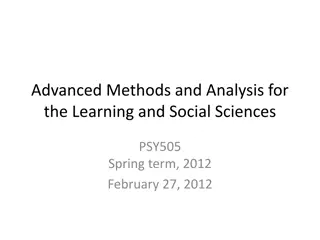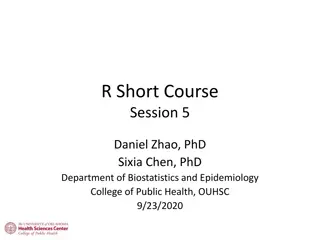Understanding Multiple Linear Regression: An In-Depth Exploration
Explore the concept of multiple linear regression, extending the linear model to predict values of variable A given values of variables B and C. Learn about the necessity and advantages of multiple regression, the geometry of best fit when moving from one to two predictors, the full regression equation, matrix notation, least squares estimation, practical applications in Microsoft Excel and R, and the key assumptions to check when using this statistical technique.
Download Presentation

Please find below an Image/Link to download the presentation.
The content on the website is provided AS IS for your information and personal use only. It may not be sold, licensed, or shared on other websites without obtaining consent from the author. Download presentation by click this link. If you encounter any issues during the download, it is possible that the publisher has removed the file from their server.
E N D
Presentation Transcript
Multiple Linear Regression Part I: Extending the Linear Model Gregory S. Karlovits, P.E., PH, CFM US Army Corps of Engineers Hydrologic Engineering Center
Why Multiple Regression? Predict values of variable A, given values of variable B, variable C, https://towardsdatascience.com/linear-regression-made-easy- how-does-it-work-and-how-to-use-it-in-python-be0799d2f159
Geometry of Best Fit A plane replaces the line when we go from one to two predictors https://stackoverflow.com/questions/47344850/scatterplot3d-regression-plane-with-residuals
Full Regression Equation Simple Linear Regression ??= ?0+ ?1??+ ?? Multiple Linear Regression ? = ?? + ? ? ?? = 0 ??? ?? = ?2 https://medium.com/@thaddeussegura/multiple-linear-regression-in-200-words-data-8bdbcef34436
Matrix Notation ? = ?? + ? 1 1 1 ?1,1 ?2,1 ??,1 ?1,? ?2,? ??,? ?1 ?? ? = ? = ?1 ?? ?0 ?? ? = ? =
Least Squares Estimation Same procedure as simple linear regression, except with matrices Find that minimizes the sum of squared errors (SSE) Solution: ? = ? ? 1? ? only if ? ? is invertible where ? is the transpose of ?
Checking Assumptions 1. The mean of yi is a linear function of the xi,j 2. All yi have the same variance 2 3. The errors are normally-distributed 4. The errors are independent
Summary Multiple regression is a generalization of simple linear regression All the same assumptions hold and need to be checked
Multiple Linear Regression Part II: Additional Considerations for Multiple Regression Gregory S. Karlovits, P.E., PH, CFM US Army Corps of Engineers Hydrologic Engineering Center
Goodness of Fit Adjust for model complexity Coefficient of Determination (R2) ?2= 1 ??? ???SST = total sum of squares Adjusted R2 ? 1 1 ?2k = number of predictors 2 ???? = 1 ? ?+1
Multicollinearity Occurs when predictors are linearly related Causes serious difficulties in model fit Coefficients are unreliable Signs can be wrong Large changes in magnitude with small changes in data Large standard errors Low significance for predictors with significant F-statistic
Testing Multicollinearity Correlation between predictor variables Variance Inflation Factor (VIF) ????= 1 ?? 1 2 https://medium.com/@mackenziemitchell6/multicollinearity-6efc5902702
Transformations Monotonic changes to the predictor and response variables Improve model fit Avoid model assumption violations Most common transformations: Logarithm Reciprocal / negative reciprocal Square/cube
Polynomial Regression Special case of the linear model with polynomial in one variable: ? = ?0+ ?1? + + ???? Two problems: Powers of x tend to be correlated (x, x2, x3, etc.) For large k, the magnitudes tend to vary over a very wide range https://www.javatpoint.com/machine-learning-polynomial-regression
Polynomial Regression Best Practices Center x-variable to reduce multicollinearity ? = ?0+ ?1? ? + + ??? ?? Limit to cubic (k = 3) if possible Never exceed a quintic (k = 5) https://imgs.xkcd.com/comics/curve_fitting.png
?=?? ? Variable Standardization ?? Standardization can help address three issues: Multicollinearity Wide ranges of powers in polynomials Different units and ranges for predictor variables Two effects: Eliminates the constant term from the model Effect magnitude of predictors directly comparable
Interaction The slope of one continuous variable on the response variable changes as the values on a second continuous variable change ? = ?0+ ?1?1+ ?2?2+ ?3?1?2 In R: lm(y ~ x1 * x2) https://stats.idre.ucla.edu/stata/faq/how-can-i-explain-a-continuous-by-continuous-interaction-stata-12/
Dummy Variables Used to indicate categorical predictor variables PRCP 563 211 229 1955 1176 495 599 287 362 1825 167 312 2294 554 1266 TMEAN TDMEAN 10.6 8.7 9.6 10.6 4.3 10.7 6.5 8.0 7.8 11.8 8.4 5.6 13.2 12.0 13.1 CA 1 0 0 1 1 1 0 1 1 1 0 0 1 1 0 NV 0 1 1 0 0 0 1 0 0 0 1 1 0 0 0 AZ 0 0 0 0 0 0 0 0 0 0 0 0 0 0 1 1.6 -3.1 -2.4 2.7 -5.4 1.9 -4.3 0.6 -0.5 8.1 -2.8 -3.9 6.5 2.5 3.7
A Note on Automated Variable Selection Stepwise regression (forward/backward) Best subsets regression Use these to support a hypothesis, not build one https://quantifyinghealth.com/stepwise-selection/
Multiple Linear Regression Part III: Use in USGS Regional Studies Gregory S. Karlovits, P.E., PH, CFM US Army Corps of Engineers Hydrologic Engineering Center
Regionalization Studies Regionalization is the use of MLR to develop prediction equations for some hydrologic variable (usually a streamflow characteristic in the USGS). MLR is used to develop a linear equation relating known values of the streamflow characteristic at a number of gaging stations in the region of interest to one or more measured characteristics of the basins above the gages (eg., basin drainage area, basin slope). Notes from Chuck Parrett, USGS
Regionalization Studies Relate a flow characteristic (peak flow, 7Q10, etc) to one or more readily available basin attributes (e.g., drainage area, slope, average precip) Assumes that a linear relationship is suitable (can transform variables using logarithms or other functions to help meet this assumption) Notes from Chuck Parrett, USGS
Regionalization Studies a) Define the region of interest b) Select appropriate gaging stations in the region and compute desired flow characteristics c) Select potential predictor variables for use in analysis d) Set up GIS database and measure predictor variables for selected stations Notes from Chuck Parrett, USGS
Regionalization Studies a) b) Consider defining subregions c) Model Validation / Error Analysis. Test each model carefully for violations of regression assumptions, outliers, and other problems d) If developing equations for a series of statistics (i.e. flow-duration percentiles or T-year flows) check for inconsistencies in predictions, and if found, adjust predictor set to eliminate or minimize inconsistencies e) After using OLS to initially determine model, use WLS or GLS regression, if necessary, to develop final models, again checking for problems with selected model. In USGS, WLS is commonly used for low flow studies and GLS is commonly used for peak flow studies. Select variables Notes from Chuck Parrett, USGS
Advanced Error Structures Ordinary Least Squares (OLS) all y-data (dependent variable) are equally reliable and independent Variance of observations equal, no correlation Weighted Least Squares (WLS) all y-data are independent but not equally reliable. Weights are used to account for differences Variance of observations unequal, no correlation Generalized Least Squares (GLS) y-data are neither independent nor equally reliable. More complicated weights are used to account for differences Variance of observations unequal, correlation Notes adapted from Chuck Parrett, USGS
OLS vs. WLS vs. GLS ? = ??? 1??? add variance of obs OLS 1 0 2 ??1 0 ? = ???? 1???? add correlation of errors WLS ? = 1 2 Variance ??? Correlation ?11 ??1 ?1? ??? ? = ??? 1? 1??? 1? ? = GLS Variance
Summary The additional model complexity in multiple regression requires checking for multicollinearity as well as all the assumptions in simple regression Multiple regression opens the types and forms of predictors you can include in your model























